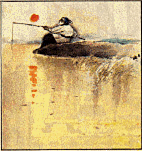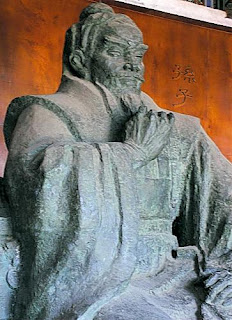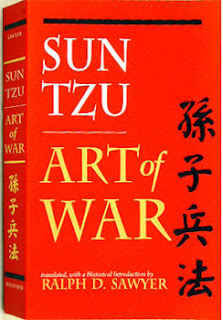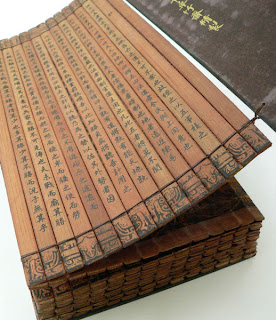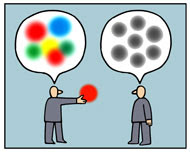
We recently guided a small startup in a brainstorming session
Through the use of Compass AE, their project team built Tangible Vision first. After hrs of debating, they connected with it in term of the goal, strategic specifics, specific objectives, and how the team operate as a team. They lead with the Tangible Vision and came up with their own Tangible Vision that they will be pursuing soon
There will be more on this company later.
###
December 30, 2007
Bright Ideas
Innovative Minds Don’t Think Alike
By JANET RAE-DUPREE
IT’S a pickle of a paradox: As our knowledge and expertise increase, our creativity and ability to innovate tend to taper off. Why? Because the walls of the proverbial box in which we think are thickening along with our experience.
Andrew S. Grove, the co-founder of Intel, put it well in 2005 when he told an interviewer from Fortune, When everybody knows that something is so, it means that nobody knows nothin’. In other words, it becomes nearly impossible to look beyond what you know and think outside the box you’ve built around yourself.
This so-called curse of knowledge, a phrase used in a 1989 paper in The Journal of Political Economy, means that once you’ve become an expert in a particular subject, it’s hard to imagine not knowing what you do. Your conversations with others in the field are peppered with catch phrases and jargon that are foreign to the uninitiated. When it’s time to accomplish a task open a store, build a house, buy new cash registers, sell insurance those in the know get it done the way it has always been done, stifling innovation as they barrel along the well-worn path.
Elizabeth Newton, a psychologist, conducted an experiment on the curse of knowledge while working on her doctorate at Stanford in 1990. She gave one set of people, called tappers, a list of commonly known songs from which to choose. Their task was to rap their knuckles on a tabletop to the rhythm of the chosen tune as they thought about it in their heads. A second set of people, called listeners, were asked to name the songs.
Before the experiment began, the tappers were asked how often they believed that the listeners would name the songs correctly. On average, tappers expected listeners to get it right about half the time. In the end, however, listeners guessed only 3 of 120 songs tapped out, or 2.5 percent.
The tappers were astounded. The song was so clear in their minds; how could the listeners not hear it in their taps?
That’s a common reaction when experts set out to share their ideas in the business world, too, says Chip Heath, who with his brother, Dan, was a co-author of the 2007 book Made to Stick: Why Some Ideas Survive and Others Die. It’s why engineers design products ultimately useful only to other engineers. It’s why managers have trouble convincing the rank and file to adopt new processes. And it’s why the advertising world struggles to convey commercial messages to consumers.
I HAVE a DVD remote control with 52 buttons on it, and every one of them is there because some engineer along the line knew how to use that button and believed I would want to use it, too, Mr. Heath says. People who design products are experts cursed by their knowledge, and they can’t imagine what it’s like to be as ignorant as the rest of us.
But there are proven ways to exorcise the curse.
/// When building the Tangible Vision, our process focuses the implementers on the importance of knowing what is the outcome and its effect before ever developing it.
In their book, the Heath brothers outline six hooks that they say are guaranteed to communicate a new idea clearly by transforming it into what they call a Simple Unexpected Concrete Credentialed Emotional Story. Each of the letters in the resulting acronym, Succes, refers to a different hook. (S, for example, suggests simplifying the message.) Although the hooks of Made to Stick focus on the art of communication, there are ways to fashion them around fostering innovation.
To innovate, Mr. Heath says, you have to bring together people with a variety of skills. If those people can’t communicate clearly with one another, innovation gets bogged down in the abstract language of specialization and expertise. It’s kind of like the ugly American tourist trying to get across an idea in another country by speaking English slowly and more loudly, he says. You’ve got to find the common connections.
/// We will touch on this point in a later entry.
In her 2006 book, Innovation Killer: How What We Know Limits What We Can Imagine and What Smart Companies Are Doing About It, Cynthia Barton Rabe proposes bringing in outsiders whom she calls zero-gravity thinkers to keep creativity and innovation on track.
When experts have to slow down and go back to basics to bring an outsider up to speed, she says, it forces them to look at their world differently and, as a result, they come up with new solutions to old problems.
/// It is all about understanding the big picture
She cites as an example the work of a colleague at Ralston Purina who moved to Eveready in the mid-1980s when Ralston bought that company. At the time, Eveready had become a household name because of its sales since the 1950s of inexpensive red plastic and metal flashlights. But by the mid-1980s, the flashlight business, which had been aimed solely at men shopping at hardware stores, was foundering.
While Ms. Rabe’s colleague had no experience with flashlights, she did have plenty of experience in consumer packaging and marketing from her years at Ralston Purina. She proceeded to revamp the flashlight product line to include colors like pink, baby blue and light green colors that would appeal to women and began distributing them through grocery store chains.
It was not incredibly popular as a decision amongst the old guard at Eveready, Ms. Rabe says. But after the changes, she says, the flashlight business took off and was wildly successful for many years after that.
MS. RABE herself experienced similar problems while working as a transient zero-gravity thinker at Intel.
/// What a title!?
I would ask my very, very basic questions, she said, noting that it frustrated some of the people who didn’t know her. Once they got past that point, however, it always turned out that we could come up with some terrific ideas, she said.
While Ms. Rabe usually worked inside the companies she discussed in her book, she said outside consultants could also serve the zero-gravity role, but only if their expertise was not identical to that of the group already working on the project.
Look for people with renaissance-thinker tendencies, who’ve done work in a related area but not in your specific field, she says. Make it possible for someone who doesn’t report directly to that area to come in and say the emperor has no clothes.
/// It is not what the consultants say. ... it is how they say it.
Janet Rae-Dupree writes about science and emerging technology in Silicon Valley.
Copyright 2007 The New York Times Company
http://www.nytimes.com/2007/12/30/business/30know.html



